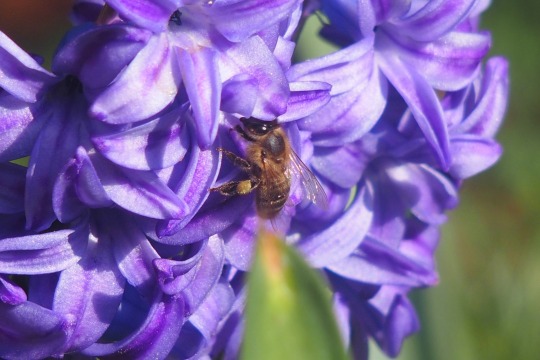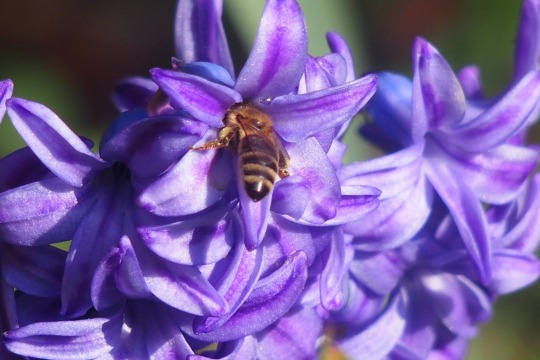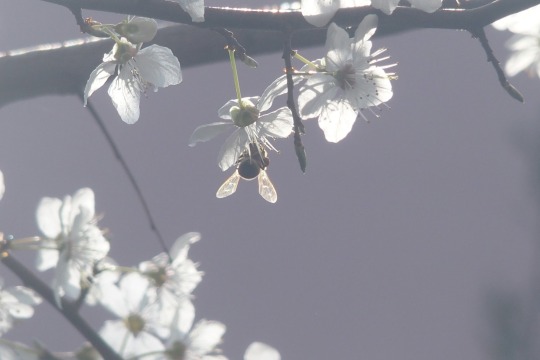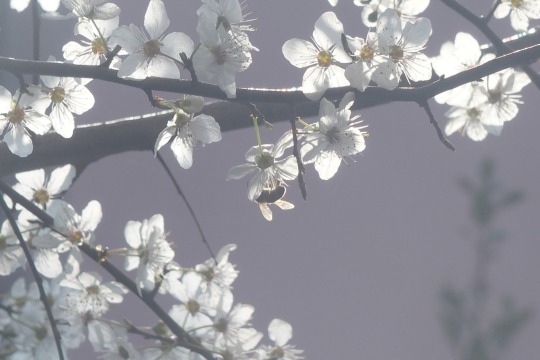Photo

Fun little fact, the reason these girls are sticking their little beehinds up in the air like that is because they are fanning “nasonov” pheromones in to the air for their fellow bee family members to smell. The nasonov pheromone basically tells the other bees “this is home now” so they all gather there and stay. ^^
You can tell when bees accept a new home when they do this for a while~
1K notes
·
View notes
Photo

Five things you can do to help bees:
1. Colour matters: Although bees have excellent colour vision it is shifted towards the ultraviolet spectrum. This means they find it hard to see red; to them it is in the same wavelength as green, making it difficult for them to distinguish the flower from the rest of the plant. Therefore it is best to plant yellow, white, violet, purple and blue flowers which can be found in plants such as; lavender, sunflowers, sage, rosemary and honeysuckle.
2. Bees get thirsty too: Putting a shallow water basin filled with pebbles, marbles or sea glass in your garden provides the bees with a water source, helping them remain longer in your garden.
3. Don’t use chemicals: When treating your garden with chemicals you are ultimately causing damage to the local honeybee system. Try using chemical free sprays made from household products if needed. Alternatively, don’t be afraid to let your weeds and wildflowers to live a little, they can be some of the most important food sources for native bees.
4. Buy local honey: By doing this you will be supporting local beekeepers who are far more likely to care about the health and wellbeing of their bees rather than the large production companies.
5. Understand that bees aren’t out to get you: Bees are vegetarians, meaning all they want is to forage pollen and nectar from flowers which can be up to three miles from their hive. Contrary to popular belief, they are not out to sting us. Learn to stay calm if they come near you and don’t swipe as it will agitate the bee.
2K notes
·
View notes
Text
8 Formidable Facts About Bees
Let’s hear it for the bees! (Let’s give the bees a ha-aa-aa-aaand!)
Spring is (supposedly) on its way, so we want to send a little love and appreciation to all the bees out there, making our everyday possible. Join us in celebrating these 8 reasons to celebrate our tiny, but mighty friends.

1. Bees make our surroundings beeee-autiful. In addition to pollinating our crops, bees are responsible for pollinating all of the things that make spring sing. And they’re no novices - they’ve been producing honey from flowering trees (fruit trees, nut trees, and bee-yond) for 10-20 million years! From the TED-Ed Lesson The case of the vanishing honeybees - Emma Bryce

2. Bees are social insects. Honey bees live together in large, well-organized family groups and engage in a variety of complex tasks not practiced by solitary insects. Communication, complex nest construction, environmental control, defense, and division of the labor are just some of the behaviors that honey bees have developed to exist successfully in social colonies. And they are not the least bit lazy: one single bee colony can pollinate 300 million flowers each day. From the TED-Ed Lesson The case of the vanishing honeybees - Emma Bryce

3. Bees are above words. They communicate through ‘dance’ and pheromones. By performing what’s referred to as the ‘waggle dance’, bees can share information about the direction and distance to patches of flowers yielding nectar and pollen, to water sources, or to new nest-site locations. From the TED-Ed Lesson Why do honeybees love hexagons? - Zack Patterson and Andy Peterson

4. Bees make great wingmen. Bees are very busy little matchmakers. The bees’ side of the whole “birds and the bees” business is to help plants find mates and reproduce. Today, around 170,000 plant species receive pollination services from more than 200,000 pollinator species, a good many of which are bees! In return, flowering plants are an abundant and diverse food source for pollinators. For instance, fossil records suggest that bees may have evolved from wasps that gave up hunting after they acquired a taste for nectar. From the TED-Ed Lesson How bees help plants have sex - Fernanda S. Valdovinos

5.Bees put food on our tables. Bees pollinate our crops on an industrial scale, generating over one-third of U.S. food production. Their work alone has contributed an estimated $15-20 billion of value to the U.S. agricultural business. From the TED-Ed Lesson The case of the vanishing honeybees - Emma Bryce

6. Bees can totally pack up a car better than you. Honeybees are some of nature’s finest mathematicians. Not only can they calculate angles and comprehend the roundness of the earth, these smart insects build and live in one of the most mathematically efficient architectural designs around: the beehive. Charles Darwin himself wrote that the honeycomb is a masterpiece of engineering. It is “absolutely perfect in economizing labor and wax.” From the TED-Ed Lesson Why do honeybees love hexagons? - Zack Patterson and Andy Peterson

7. Bees are hooked on coffee, too. When bees pollinate coffee plants, they consume low doses of caffeine from the coffee flower nectar, which means that bees are **BUZZZZZING** from a caffeine high just like us, AND helping us to get our coffee fix on the daily! From the TED-Ed Lesson The case of the vanishing honeybees - Emma Bryce

8. Honeybees are disappearing at astonishing rates. Not to be a **buzzkill**, but here’s a not-so-fun fact. In the past decade, the U.S. honeybee population has been decreasing at an alarming and unprecedented rate. Bee mortality rates in commercial production have more than doubled in the last decade, and in 2015, 40% of bee colonies were reported lost in just a single year. There are a variety of factors causing Colony Collapse Disorder, and scientists everywhere are working to prevent further loss of bees. Keep reading to see how you can help. From the TED-Ed Lesson The case of the vanishing honeybees - Emma Bryce
Love bees as much as we do? Well, let’s give the bees a hand, for real! Plant some bee-friendly flowers this spring and remember, when bees have access to good nutrition, we have access to good nutrition through their pollination services.
4K notes
·
View notes
Link
Piante amiche delle api. Che abbiate un piccolo balcone o un intero giardino a disposizione, è tempo di piantare fiori ed essenze per attirare e nutrire le api, anche in città. Facelia: produce una miriade di fiori di colore blu-violetto dalla primavera all’autunno. Trifoglio: ottimi tappezzanti e da foraggio, riescono a coprire con la fioritura […]
0 notes
Text
https://www.apicolturavaresina.it/content/piante-amiche-api
Fiori per le api
0 notes
Text
Pollinator-friendly plants
Flowers by month
By Mark Patterson BSc
Here is a list of some of Mark's recommendations, but there are many other plants that pollinators like too. You might also like to consult the RHS list of bee-friendly plants.
The plants suggested here are recommended for garden planting only and are not suitable for planting in wild places such as nature reserves.
0 notes
Text
Arbusti e fiori per le amiche api
0 notes
Photo

February honey bee!!
Feb. 28, 2018
Southeastern Pennsylvania
769 notes
·
View notes
Text
honey bee body language guide
a quick reference for understanding honey bees !!!
(EDITED FOR MISINFORMATION!!)
🐝 approaching you
🌱 they want to know if you’re a flower, a threat, or neither ! don’t swat or get too close to their hive, and you’re not a threat.
🐝 landing on you (often you can see her cleaning herself, if you watch carefully)
🌱 she’s either tired or, on the rare occasion, deciding to sting you. don’t squish her !!! she’s probably just chillin with you, but if you want her off, blow her off. she’ll fall and fly away !
🐝 buzzing becomes high pitched
🌱 think angry bees in a cartoon. you can actually hear the change ! this means they’re getting agitated
🐝 circling your head
🌱 this is a warning that you’re being threatening and you need to leave ! calmly move away from the hive or the bee.
🐝 if you’re close to the hive: sending significantly more bees into the air
🌱 usually means they either want to know what’s happening or there’s a threat to the hive ! you should probably leave.
🐝 divebombing you in a headbutt, bouncing off
🌱 this is the most explicit “if you do not leave, i will sting you” that honey bees have. it’s the last warning !
💞some extras !💞
🐝 laying on the sidewalk
🌱 if she’s alive, she’s either resting or in trouble. she could be diseased or usually, in winter, too cold. some folks feed them honey or sugar water ! i’ve had a few good experiences in just letting them sit on my hand and warm up for a while before she flies off. if not, i leave her somewhere she won’t be stepped on. if you’re afraid to touch a bee but still wanna help, try getting her somewhere safer with a leaf or something ! if it doesn’t work, don’t feel too guilty. they’re like cells in an organism, some are always going to be dying as new ones are being born.
(EDIT: i’ve been corrected !!! i’m so, so, so sorry for spreading this misinformation. please don’t feed bees ! honey could introduce diseases to the hive and while sugar water gives them a burst of energy, it could do more damage in their foraging habits in the long term.)
🐝 a BUNCH of bees clumped onto something or flying in a slow cloud
🌱 more than likely a swarm ! bees “swarm” when their hive is big and healthy enough to branch off into two hives, or when they’re moving houses ! you’ll never find a honey bee in a better mood than when they’re swarming. observe them from a safe distance, it’s super cool !
🐝 moving her front legs from her mouth over her face
🌱 she’s cleaning herself ! just like how cats do !
🐝 moving a leg from her mouth to her rear leg
🌱 she’s packing pollen ! she wets it with her mouth and then packs it into her pollen sac, which is basically just hairs on her leg shaped into a basket ! that’s why you see the yellow / orange dots on their back legs. they’re bringing it back to the hive !
🐝 dragging another bee out of the hive
🌱 they’re either moving a corpse or a diseased or malformed bee that will die soon. think of it like your body flushing out bad stuff– the bees are like cells of an organism, working toward the whole.
🐝 standing away from her hive on the landing pad, beating her wings
🌱 she’s fanning the hive !! this keeps the brood and honey at a safe temperature.
💞 feel free to add on or ask about more !! 💞
28K notes
·
View notes
Text
Facts about Honey Bees🐝
1. The honey bee has been around for millions of years.
2. Honey bees, scientifically also known as Apis mellifera, which mean “honey-carrying bee”, are environmentally friendly and are vital as pollinators.
3. It is the only insect that produces food eaten by man.

4. Honey is the only food that includes all the substances necessary to sustain life, including enzymes, vitamins, minerals, and water; and it’s the only food that contains “pinocembrin”, an antioxidant associated with improved brain functioning.
5. Honey bees have 6 legs, 2 compound eyes made up of thousands of tiny lenses (one on each side of the head), 3 simple eyes on the top of the head, 2 pairs of wings, a nectar pouch, and a stomach.

6. Honey bees have 170 odorant receptors, compared with only 62 in fruit flies and 79 in mosquitoes. Their exceptional olfactory abilities include kin recognition signals, social communication within the hive, and odor recognition for finding food. Their sense of smell is so precise that it could differentiate hundreds of different floral varieties and tell whether a flower carried pollen or nectar from metres away.
7. The honey bee’s wings stroke incredibly fast, about 200 beats per second, thus making their famous, distinctive buzz. A honey bee can fly for up to six miles, and as fast as 15 miles per hour.
8. The average worker bee produces only about 1/12th teaspoon of honey in her lifetime. Doesn’t this fact make you love every drop of honey? Read and you will understand why it makes so much sense to say: “as busy as a bee”.
9. A hive of bees will fly 90,000 miles, the equivalent of three orbits around the earth to collect 1 kg of honey.
10. It takes one ounce of honey to fuel a bee’s flight around the world (National Honey Board).
11. A honey bee visits 50 to 100 flowers during a collection trip.
12. The bee’s brain is oval in shape and only about the size of a sesame seed (iflscience.com), yet it has remarkable capacity to learn and remember things and is able to make complex calculations on distance travelled and foraging efficiency.
13. A colony of bees consists of 20,000-60,000 honeybees and one queen. Worker honey bees are female, live for about 6 weeks and do all the work.
14. The queen bee can live up to 5 years and it’s role is to fill the hive with eggs. She is the busiest in the summer months, when the hive needs to be at its maximum strength, she lays up to 2500 eggs per day. The queen bee has control over whether she lays male or female eggs. If she uses stored sperm to fertilize the egg, the larva that hatches is female. If the egg is left unfertilized, the larva that hatches is male. In other words, female bees inherit genes from their mothers and their fathers while male bees inherit only genes from their mothers. Click here to learn more about the Honey Bee Life Cycle
15. Larger than the worker bees, the male honey bees (also called drones), have no stinger and do no work at all. All they do is mating. In fact, before winter or when food becomes scarce, female honeybees usually force surviving males out of the nest.
16. Each honey bee colony has a unique odour for members’ identification.
17. Only worker bees sting, and only if they feel threatened and they die once they sting. Queens have a stinger, but they don’t leave the hive to help defend it. It is estimated that 1100 honey bee stings are required to be fatal.
18. The worker bees produce honeycomb which comprises hexagon shaped cells through the consumption of honey produced from the collected flower nectar. To produce one pound of beeswax, six to eight pounds of honey are ingested
19. Honey bees communicate with one another by dancing. More on their awesome sense of time, communication of distance and direction in “The Awesome Honeybee Dance”.
20. honey bee facts imageDuring winter, honey bees feed on the honey they collected during the warmer months. They form a tight cluster in their hive to keep the queen and themselves warm.
“Unique among all God’s creatures, only the honeybee improves the environment and preys not on any other species.”
~ Royden Brown
3K notes
·
View notes
Text



0 notes
Photo





API: Beewatching in giardino ai tempi del Covid
1 note
·
View note
